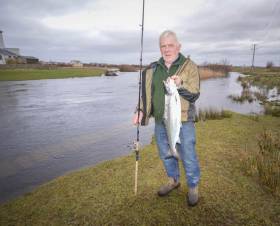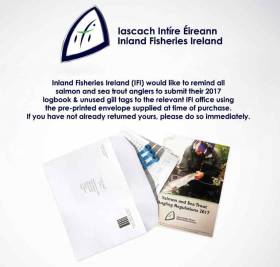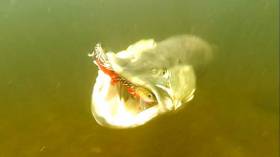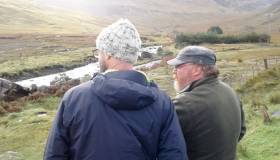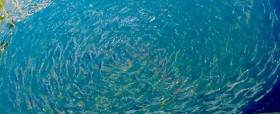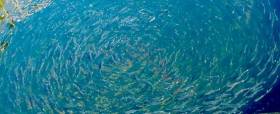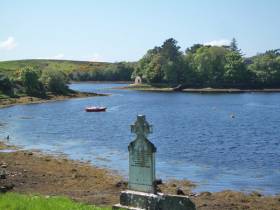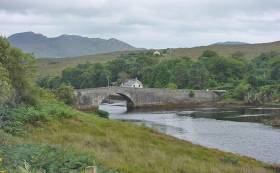Displaying items by tag: Salmon
Report Confirms Presence Of Farmed Atlantic Salmon In Galway & Mayo Rivers
#Angling - As many as 500 farmed salmon could have entered a number of rivers in Galway and Mayo last autumn, according to a new report from Inland Fisheries Ireland (IFI).
The report into the incident in the Western River Basin District also confirms that no reports of escapes in the relevant period were made by local salmon farm owners, as previously reported on Afloat.ie.
The reporting of escapes to the Department of Agriculture, Food and the Marine (DAFM) are a condition of aquaculture licences.
IFI’s reports says that “up to 500 escaped farmed salmon may have entered western salmon rivers during the August/September period 2017.”
And it adds “that the presence of sexually mature farmed salmon in rivers poses a potential threat to local wild salmon populations from interbreeding and other ecological effects.”
In October 2017, the board of Inland Fisheries Ireland issued a statement noting that it :continues to have concerns regarding the impacts of fish farms on Ireland’s precious wild fish.
“The licencing regime and best management practice should provide assurance to the State that controls are in place that safeguard our heritage. This does not appear to be the case in this instance.
“Inland Fisheries Ireland supports sustainable fish farming but cautions against the renewal and/or award of licences where conditions are not being adhered to. The board recommends immediate strict enforcement and audit of existing licence conditions to ensure compliance and ultimately a sustainable resource for all.”
Speaking on the publication of the new report, IFI head of R&D Dr Cathal Gallagher said: “While a small number of farmed salmon spawning in a catchment may not have a detectable long-term effect on the wild salmon population, repeated escapes of large numbers of farmed fish have the potential to cause serious damage to vulnerable wild salmon populations.
“The large number of escaped farmed salmon entering into these rivers, with a high proportion of males likely to be sexually mature, presents a potential threat to local wild salmon populations.
“IFI will continue to monitor the situation and may need to conduct longer-term genetic studies on the impact of the presence of these farmed salmon.”
The full report is available to download below.
Likely Story Of 2018’s First Spring Salmon Landed In Leitrim
#Angling - Inland Fisheries Ireland has confirmed that the first spring salmon of 2018 was caught earlier this week in Co Leitrim.
Well-known local angler Bill Likely landed the 7.5lb salmon on the River Drowes on Tuesday 30 January. The sea-liced fish was taken on a Black and Gold Rapala from the Point of the Meadow Pool shortly before 1pm.
Water levels on the river were high at the time, as they have been at the fishery for the first month of the season, but have been decreasing in recent days.
Sean Kyne, Minister of State with responsibility for the inland fisheries sector, congratulated Likely on this achievement.
“To catch the first salmon of the year is an accolade prized among anglers and marks the return of the fishing season every January,” the minister said. “Using the event to support a worthy cause such as hospice services puts the iconic salmon at the heart of the angling as well as the broader community.”
“Protecting and sustaining our salmon resource as a vector for development and tourism in peripheral rural areas is among my top priorities.”
The first fish, as is traditional, will be prepared for a tasting event to benefit local charities — and on this occasion, the North West Hospice, which ‘provides specialist care with compassion for those living with life-limiting illness in our community’, will be the beneficiary of an event at the Foxes Lair Bar & Restaurant in Bundoran tomorrow Friday 9 February from 8pm.
To mark the catch, fishery owner Shane Gallagher presented the Drowes Perpetual Cup to a delighted Likely, who works on the fishery and is familiar to local anglers, well known for his generosity with advice and local insights.
Ciaran Byrne, CEO of Inland Fisheries Ireland (IFI), said: “Official confirmation of the first salmon catch of the year is always a key event. Last year, the first salmon was caught in the Careysville Fishery on the Munster Blackwater in Cork on February 1st.
“IFI staff have confirmed the appearance of spring salmon on a number of Donegal fisheries over recent days. The board of IFI is concerned about the declining abundance of salmon and urges all salmon anglers to practice catch and release angling on all open salmon waters even where there is an available quota.”
Byrne continued: “We have a wonderful fisheries resource in this country that doesn’t just benefit anglers but offers rural communities sustainable tourism and job opportunities outside of the traditional tourist seasons.
“Inland Fisheries Ireland continues to work with these communities to develop our angling infrastructure and improve access, through extensive funding grants and sponsorship, with a view to increasing angling participation and growing local economic growth as a result.”
Anglers looking for fishing information in Ireland in 2018 can visit the Fishing in Ireland website for the latest news and fishing reports.
For those looking to try out fishing for the first time, IFI will run a number of education and outreach initiatives throughout the year with all information posted on fisheriesireland.ie.
IFI is also inviting the public to help protect and conserve the fisheries resource during the year by reporting incidents of illegal fishing, water pollution and invasive species to its confidential hotline at 1890 34 74 24 or 1890 FISH 24.
78 Rivers Open for Salmon Angling in 2018
Mr. Sean Kyne T.D., Minister with responsibility for the inland fisheries sector, has approved a suite of regulations and bye-laws that will govern the wild salmon and sea trout fisheries in 2018. These will come into effect from Monday 1, January 2018.
Minister Kyne said “In all, 78 rivers will open for angling activity in 2018 and this will provide opportunities for all to share this important natural resource on a sustainable basis. 42 of these rivers will be fully open with a further 36 for angling on a “catch & release” basis. I had asked Inland Fisheries Ireland to carry out a full review of the Catch and Release element of fisheries management policy ahead of the 2018 season and this has resulted in an additional 12 rivers open on a Catch and Release basis which otherwise would have been closed.”
Minister Kyne had received management advice from IFI in relation to over 140 genetically individual wild salmon stocks in Ireland, in advance of setting out the legislation for 2018. This advice was also made available as part of a public consultation process. This was based on the scientific assessment of the current status of all stocks carried out by the independent Standing Scientific Committee on Salmon. This committee comprises scientists from a range of organisations.
Over 130 submissions were considered as part of the public consultation process. Based on this the Minister has introduced conservation measures for the management of the wild salmon and sea trout fishery in 2018.
Management advise supported by scientific assessment of rivers/estuaries/harbours is that:-
78 Rovers should be open for angling of which
42 rivers should be open as a surplus of fish has been identified in these rivers;
36 rivers should be classified as open for “catch and release” angling;
68 rivers should be closed as they have no surplus of fish available for harvest.
Summary of main changes to the management of the wild salmon fishery in 2017
|
Fishery District |
River |
2017 |
2018 |
|
Dundalk |
Glyde |
Open |
Catch And Release |
|
Dundalk |
Dee |
Catch And Release |
Closed to 30 April/Catch And Release from 01 May |
|
Wexford |
Slaney |
Closed |
Closed to 30 April/Catch And Release from 01 May |
|
Kerry |
Ferta |
Open |
Catch And Release |
|
Kerry |
Inny |
Open |
Catch And Release |
|
Bangor |
Glenamoy |
CATCH AND RELEASE |
Open |
|
Bangor |
Shramore |
Closed |
Catch And Release |
|
Ballyshannon |
Eske |
Closed |
Catch And Release |
|
Ballyshannon |
Owenwee (yellow) |
Closed |
Catch And Release |
|
Letterkenny |
Owenea/Owentocker |
Open |
Catch And Release |
|
Letterkenny |
Gweedore (Crolly) |
Open |
Catch And Release |
|
Letterkenny |
Tullaghobegley |
Closed |
Catch And Release |
|
Letterkenny |
Leannan |
Catch And Release |
Closed to 30 April/Catch And Release from 01 May |
- Wild Salmon and Sea Trout Tagging Scheme (Amendment) Regulations S.I. No. 602 of 2017
These regulations provide for, the quotas of fish that can be harvested by commercial fishing engines and rod and line from those rivers identified in Schedule 2. The Regulations also provide for the use of brown tags in specified rivers which are identified in Schedule 4.
- Angling Byelaw No. 955, 2017
This Bye-law prohibits the use of any fish hooks, other than single barbless hooks, and also prohibits the use of worms as bait in angling for all species of fish in the waters specified in the Bye-law.
- Conservation of Salmon and Sea trout (Bag Limits) Bye-law No. 956, 2017
Provides for an annual bag limit of 10 fish being either salmon or sea trout (over 40 cm) per angler and provides for a season bag limit of 3 fish in the period 1 January to 11 May, a daily bag limit of 3 fish from 12 May to 31 August and a daily bag limit of 1 fish from 1 September to the end of the season. The Bye-law also provides for the use of single barbless hooks and prohibits the use of worms as bait once the specified numbers of fish have been caught in the specified periods.
- Conservation of Salmon and Sea trout (Catch and Release) Bye-law No. 957, 2017
Provides for catch and release in respect of salmon and sea trout (over 40 cm) in rivers that are meeting at least 50% of their Conservation Limit as mentioned in the Bye-law. The Bye-law also provides for the use of single barbless hooks and prohibits the use of worms as bait in angling for salmon and sea trout over 40 cm
- Conservation of Salmon and Sea Trout (RiverSuir) Bye-law No. 958, 2017.
This Bye-Law provides for catch and release in angling for salmon (any size) and sea trout (over 40cm) in the RiverSuir (including the waters of the Rivers Clodiagh, Lingaun and Blackwater) and also prohibits the use of worms, prawn, shrimp or any other crustacean, or artificial forms thereof, as bait and any fish hooks other than single barbless hooks during the period 17 March to 30 Sept, 2018.
- Conservation of Sea Trout Bye-law No. 959, 2017
This Bye-law provides for a daily bag limit of 3 sea trout (less than 40 cm in length) and provides for the use of single barbless hooks and prohibits the use of worms as bait once the specified number of sea trout have been caught.
- Conservation of Salmon and Sea Trout (Closed Rivers) Bye-law No. C.S. 323, 2017
Prohibits the taking or attempting to take by rod and line salmon and sea trout (over 40 cm) in the rivers specified in the Bye-law.
Inland Fisheries Ireland: Reminder to All Salmon & Sea Trout Anglers
Inland Fisheries Ireland (IFI) would like to remind all salmon and sea trout anglers to submit their 2017 logbook and unused gill tags to the relevant IFI office using the pre-printed envelope supplied at time of purchase.
Your contribution to the management of our wild Atlantic salmon stocks for 2018 is very important. 69% of anglers returned their logbook and unused tags last year.

For further information click here
Minister Welcomes Stock Management Plan & Survey For Lough Corrib Tributary
#Angling - Sean Kyne, Minister with responsibility for Inland Fisheries, has welcomed the development by Inland Fisheries Ireland (IFI) of a specific stock management plan for Galway’s Owenriff system aimed at removing pike from the system as a significant step forward.
Stock management operations are normally commenced in February each year and the Owenriff plan will be implemented for 2018.
Minister Kyne said: “I met recently with the board and senior management of Inland Fisheries Ireland to discuss this, and other issues, and it has now been agreed that, in line with current policy, a stock management plan explicitly for the Owenriff will be implemented in a more intensive focus on the system to facilitate the recovery of the salmonid populations.
“It has also been agreed that IFI will continue to implement a stock management programme for the entire Corrib catchment, in line with its current policy,” he added.
The minister also welcomed confirmation by IFI that the results of a fish population survey of the Owenriff system, which was undertaken during the summer of 2017, will be reported on in January 2018.
Dr Cathal Gallagher, head of research and development at IFI, said: “We have listened to local stakeholders and staff in relation to threats posed to salmon and trout populations in the Owenriff, a tributary of Lough Corrib.
“To understand the scale of the issues reported and to support evidence-based management, Inland Fisheries Ireland conducted a fish population survey in late June and late July 2017. We have since worked in the laboratory and with relevant analytical tools to understand the dynamics of the fish stocks in this catchment.
“We have also reviewed mitigation actions that could be taken to restore damage incurred by specific stocks. A proposed rehabilitation plan for the system will be delivered in parallel to the fish stock survey report.”
As part of its research into fish population in the Owenriff system, IFI surveyed 17 river sites and two lakes using standard fish population sampling methods.
IFI staff are currently analysing the data and comparing it to data from previous surveys and neighbouring catchments to determine the status of the fish stocks and to assess change.
A fish stock survey report, which will be available in January, will document important metrics including fish species richness, fish abundance, length frequency, age and growth, and fish ecological status.
Supported by analysis of the survey results, and taking account of the ecology of specific systems, IFI says it will deliver a detailed plan which will focus on the rehabilitation of endangered fish populations in this important catchment.
This will include plans to maintain the genetic diversity of salmon and trout stocks in the Owenriff catchment.
Biologist Presents Novel Approach To Boosting Wild Atlantic Salmon Numbers In Irish Rivers
#Angling - An international fisheries biologist has suggested a novel approach to boosting numbers of wild Atlantic salmon in Irish rivers — by moving wild fry from more abundant areas to weaker spots within a catchment.
Dr Kyle Young, a research associate from the University of Zurich, was recently invited to give a presentation as part of the Inland Fisheries Ireland (IFI) Research Seminar Series, at which he outlined his proposal for translocation of salmon fry.
Natural survival bottlenecks are experienced by Atlantic salmon through each stage of its lifecycle, from egg to fry, fry to parr, parr to smolt and so on, he outlined. Under natural conditions, the vast majority of wild salmon fry do not survive to become parr.
These so called “doomed majorities” can be present in sections of rivers with an initial abundance of emergent salmon fry, whose subsequent population size is constrained by density-dependent mortality and by the carrying capacity of the habitat.
Dr Young proposes that such fry could be translocated from these areas to low or non-productive sections of the same river where suitable habitat is present, in an effort to potentially boost the overall production of native wild salmon populations.
This approach may minimise the unintended negative consequences of more conventional salmon stocking programmes where wild salmon broodstock are taken from spawning areas and eggs fertilised in the hatchery.
Hatchery-origin fish are also typically less well-adapted to thrive than their wild compatriots and the overall fitness of the wild component of a population may be compromised through lower overall survival, interbreeding and competition for resources with stocked fish.
IFI’s head of R&D Dr Cathal Gallagher said: “We were delighted to welcome Dr Young to our headquarters in Citywest to further explore the potential of this novel proposal to boost wild Atlantic salmon populations.
“This iconic species is of both major conservation and socio-economic importance to Ireland. Although wild salmon are widely distributed in Irish freshwaters, their long-term sustainability remains under continued threat from a variety of factors. These include habitat degradation, issues related to aquaculture, oceanic and climatic change, pollution, illegal fishing and over-fishing.”
Following the seminar, Dr Young visited the National Salmonid Index Catchment (NSIC) at the River Erriff, the Galway Salmon Fishery and the Cong hatchery facility to further discuss his theorised approach to salmon stocking with IFI management, field staff and researchers.
IFI are discussing the possibility of undertaking experimental trials with this novel approach to boost juvenile salmon production upstream of their trapping facilities in the Erriff catchment.
#Salmon - Inland Fisheries Ireland (IFI) confirms that 65 farmed salmon have been caught in five rivers in Counties Galway and Mayo.
The news follows concerns raised by wild salmon conservationists since a major fish kill by jellyfish stings that has wiped out stocks along the West Coast in recent weeks, as previously reported on Afloat.ie.
But fears regarding salmon farm management and oversight have also grown as at yesterday (Monday 9 October), IFI understood that no escapes of farm salmon had been reported to the Department of Agriculture, Food and the Marine by salmon farm owners.
“The licencing regime and best management practice should provide assurance to the State that controls are in place that safeguard our heritage, this does not appear to be the case in this instance,” said the IFI board in a statement.
As of yesterday, 65 farmed salmon escapees have turned up on the Delphi, Erriff, Kylemore/Dawros, Newport and Bunowen rivers.
The scale of the escape is not fully understood at this time as the majority of fish were caught by anglers, who generally only encounter a small proportion of salmon in a river.
IFI says its scientists are analysing captured fish in an attempt to identify the history and maturity status of the farmed salmon, and create a fuller picture of the risks to wild salmon stocks.
Of the farmed fish examined by yesterday, three males were mature on capture and had the potential to spawn in the wild.
IFI adds that the various catchments are already under pressure due to significant decreases in salmon runs over the last twenty years.
All fish entering the Erriff are monitored in an upstream trap allowing for the removal of farmed fish. But there are no such trapping facilities available on the other systems.
IFI says its staff will continue to monitor the situation despite the difficulty in assessing exact numbers without details from the affected fish farms.
Jellyfish To Blame For Major Salmon Farm Fish Kill
#Jellyfish - Four-fifths of the farmed salmon stock at Killary Harbour has been lost to fatal jellyfish stings over the last few weeks, according to The Irish Times.
The Marine Institute has confirmed that naturally occurring swarms of the tiny Muggiaea atlantica and the larger mauve stinger are responsible for the deaths of tens of thousands of fish across four fish farms from Connemara to Bantry Bay.
It marks the worst recorded salmon farm fish kill since 250,000 salmon were lost in Northern Ireland in 2008.
Farmed salmon in Connemara alone was worth €38 million in 2016, as the Connacht Tribune reports.
Meanwhile, wild salmon conservationists have also raised concerns over the potential impact of farmed fish that have reportedly escaped into Ireland’s salmon rivers as a result.
The Irish Times has more on the story HERE.
#Angling - An angling bye-law focusing on salmon and sea trout has come into effect for Burrishoole, Co Mayo.
Sean Kyne, Minister of State with responsibility for Inland Fisheries, introduced the Conservation of Salmon and Sea Trout Shramore (Burrishoole)(Catch and Release) Bye Law No 951 into operation on Tuesday 13 June.
The new bye-law provides for catch and release angling for salmon and sea trout over 40cm in length in the Shramore (Burrishoole) system, and applies to Lough Furnace and the Seven Arch Bridge on the L5435 (old Newport Road).
Operative from Wednesday 14 June till Saturday 30 September, the bye-law and provides for the use of single barbless hooks while prohibiting the use of worms as bait in angling for salmon and sea trout.
‘Catch and release’ angling refers to the method of carefully handling any fish caught and immediately returning the fish alive to the water. This form of angling has a significant positive impact on the survival rate of released fish.
In addition, salmon and sea trout caught by fly fishing using single barbless hooks have a greater chance of survival than fish caught on barbed hooks. Barbless hooks do less damage, are easier to remove and reduce handling time which can be an important factor influencing survival.
Salmon and sea trout are some of Ireland’s main wild fish species attracting domestic and overseas anglers alike. Angling contributes €836 million to the Irish economy annually and supports upwards of 11,000 jobs which are often in rural communities.
Dr Ciaran Byrne, chief executive of Inland Fisheries Ireland, said: “Our salmon and sea trout stocks are extremely valuable. These new measures at Shramore, Burrishoole, will allow us to introduce a number of important methods which will help us protect these populations into the future.”
Anglers are requested to familiarise themselves the details of the new bye-law, available as a PDF to read or download HERE.
Innovative Fish Counter Opens On Donegal’s River Lackagh
#Angling - Sean Kyne TD, Minister of State with responsibility for Inland Fisheries, has officially opened a new fish counter facility in the designated spring salmon fishery on the River Lackagh.
The project, which was devised and delivered by Inland Fisheries Ireland, was completed in recent months and will provide important data for the future management of spring salmon, grilse and sea trout stocks for the River Lackagh catchment, which incorporates Lough Beagh, situated in Glenveagh National Park.
This major infrastructural project, which was funded under IFI’s Salmon Conservation Fund, includes installation of a crump weir, Logie fish counter and access road to the Lackagh River at Creeslough, Co Donegal.
The counter will provide verifiable, accurate data on the size, duration and timing of fish migration through the fishery.
The River Lackagh counter project was developed by IFI in response to closure of the River Lackagh salmon fishery in 2007, when scientific advice indicated that salmon stocks had fallen to below their conservation limit.
The salmon fishery remained closed to enable fish stocks re-build until 2013 when electrofishing surveys confirmed that juvenile salmon stocks had recovered sufficiently to allow for the re-opening of the salmon fishery on a ‘catch and release’ basis.
IFI says the new counter will be a valuable addition to its national suite of index counters and represents the organisation’s first counter on the north Donegal coast.
Minister Kyne said he is “delighted to officially open this fish counter which will help protect fish stocks in the area. Angling is a valuable asset to local communities here in Donegal. This development will help us ensure the sustainability of fish populations for future generations.”
IFI chief executive added: “This fish counter provides real time data on fish stocks in the fishery and allows us to adapt to changing stock levels. This is crucial both from a conservation and economic viewpoint as this fishery contains valuable wild fish populations.
“I would like to acknowledge all our partners in this project who recognised the importance of this project and worked with us to delivery this facility for the local area.”
Angling in Ireland currently contributes €836 million to the Irish economy annually, supporting upwards of 11,000 jobs which are often in rural and peripheral communities.
IFI’s National Strategy for Angling Development aims to ensure the sustainable development of the natural angling resource in a conservation focused manner. If realised, the strategy could help increase the economic contribution of angling by €53 million annually and support 18,000 jobs.
IFI collaborated with several partners on the River Lackagh project including Donegal County Council, the National Parks and Wildlife Service (NPWS) and ESB Networks. IFI also acknowledges the assistance of Creeslough & District Angling Association, owners Hillary Keegan and John Coyle and service providers WD Buchanan & Co Ltd, H Harkin Plan Hire Ltd and Source Civil Ltd.




























